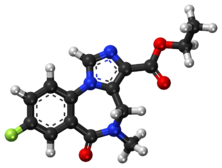Flumazenil
 |
|
 |
|
| Clinical data | |
|---|---|
| Trade names | Anexate, Lanexat, Mazicon, Romazicon |
| AHFS/Drugs.com | Monograph |
| Pregnancy category |
|
| Routes of administration |
IV |
| ATC code | |
| Legal status | |
| Legal status | |
| Pharmacokinetic data | |
| Metabolism | Hepatic |
| Biological half-life | 7-15 min (initial) 20-30 min (brain) 40-80 min (terminal) |
| Excretion | Urine 90-95% Feces 5-10% |
| Identifiers | |
|
|
| Synonyms | ethyl 8-fluoro- 5,6-dihydro- 5-methyl- 6-oxo- 4H- imidazo [1,5-a] [1,4] benzodiazepine- 3-carboxylate |
| CAS Number | |
| PubChem CID | |
| IUPHAR/BPS | |
| DrugBank | |
| ChemSpider | |
| UNII | |
| KEGG | |
| ChEBI | |
| ChEMBL | |
| ECHA InfoCard | 100.128.069 |
| Chemical and physical data | |
| Formula | C15H14FN3O3 |
| Molar mass | 303.288 g/mol |
| 3D model (Jmol) | |
|
|
|
|
Flumazenil (also known as flumazepil, code name Ro 15-1788) is a selective benzodiazepine receptor antagonist available by injection and intranasal. It has antagonistic and antidote properties to therapeutically used benzodiazapenes, through competitive inhibition.
It was first introduced in 1987 by Hoffmann-La Roche under the trade name Anexate, but only approved by the FDA on December 20, 1991. Flumazenil went off patent in 2008 so at present generic formulations of this drug are available. Intravenous flumazenil is primarily used to treat benzodiazepine overdoses and to help reverse anesthesia. Administration of flumazenil by sublingual lozenge and topical cream has also been tested.
Flumazenil is of benefit in patients who become excessively drowsy after benzodiazepines are used for either diagnostic or therapeutic procedures.
It has been used as an antidote in the treatment of benzodiazepine overdoses. It reverses the effects of benzodiazepines by competitive inhibition at the benzodiazepine binding site on the GABAAreceptor. There are many complications that must be taken into consideration when used in the acute care setting. These include lowered seizure threshold, agitation, and anxiousness. Flumazenil's short half-life requires multiple doses and careful patient monitoring to prevent recurrence of overdose symptoms.
It is also sometimes used to reverse the effects of benzodiazepines after surgery in a manner similar to naloxone's application to reverse the effect of opiates and opioids following surgery. This requires careful monitoring by an anesthesiologist due to potential side effects and serious risks associated with both over-administering flumazenil and the removal of patient life-support and monitoring equipment before the benzodiazepines have worn off (due to flumazenil masking their continued effect).
...
Wikipedia
